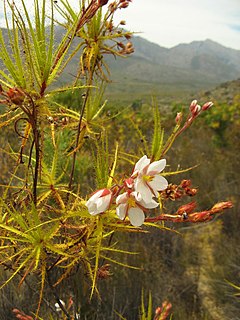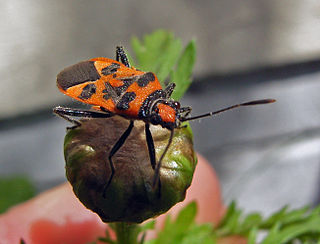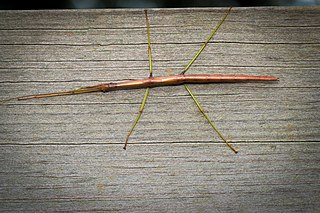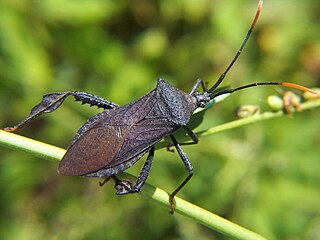Stridulation is the act of producing sound by rubbing together certain body parts. This behavior is mostly associated with insects, but other animals are known to do this as well, such as a number of species of fish, snakes and spiders. The mechanism is typically that of one structure with a well-defined lip, ridge, or nodules being moved across a finely-ridged surface or vice versa, and vibrating as it does so, like the dragging of a phonograph needle across a vinyl record. Sometimes it is the structure bearing the file which resonates to produce the sound, but in other cases it is the structure bearing the scraper, with both variants possible in related groups. Common onomatopoeic words for the sounds produced by stridulation include chirp and chirrup.

The Phasmatodea are an order of insects whose members are variously known as stick insects, stick-bugs, walking sticks, stick animals, or bug sticks. They are also occasionally referred to as Devil's darning needles, although this name is shared by both dragonflies and crane flies. They can be generally referred to as phasmatodeans, phasmids, or ghost insects, with phasmids in the family Phylliidae called leaf insects, leaf-bugs, walking leaves, or bug leaves. The group's name is derived from the Ancient Greek φάσμα phasma, meaning an apparition or phantom, referring to their resemblance to vegetation while in fact being animals. Their natural camouflage makes them difficult for predators to detect; still, many species have one of several secondary lines of defense in the form of startle displays, spines or toxic secretions. Stick insects from the genera Phryganistria, Ctenomorpha, and Phobaeticus include the world's longest insects.

Leptoglossus phyllopus or Eastern leaf-footed bug is a species of leaf-footed bugs in the same genus as the western conifer seed bug (L. occidentalis. The Eastern leaf-footed bug is found throughout the southern United States, from Florida to California, through Mexico, and as far south as Costa Rica.

Roridula is a genus of evergreen, insect-trapping shrubs, with two species, of about 1⅓–2 m. It is the only genus in the family Roridulaceae. It has thin, woody, shyly branching, upright, initially brown, later grey stems, with lance- to awl-shaped leaves crowded at their tips. The star-symmetrical flowers consist from the outside in of five, green or reddish, free sepals, alternating with five white, pink or purple, free petals. Further to the middle and opposite the sepals are five stamens with the anthers initially kinked down. These suddenly flip up if the nectar-containing swelling at its base is being touched. The center of the flower is occupied by a superior ovary. The leaves and sepals carry many sticky tentacles of different sizes, that trap insects. Roridula does not break down the insect proteins, but bugs of the genus Pameridea prey on the trapped insects. These later deposit their feces on the leaves, which take up nutrients from the droppings. The species can be found in the Western Cape province of South Africa. They are commonly known as dewstick or fly bush in English and vlieëbos or vlieëbossie in Afrikaans.

The western conifer seed bug, sometimes abbreviated as WCSB, is a species of true bug (Hemiptera) in the family Coreidae. It is native to North America west of the Rocky Mountains but has in recent times expanded its range to eastern North America, to include Ontario, Nova Scotia, Maine, Pennsylvania, New York, Connecticut, Massachusetts, and New Hampshire, and has become an accidental introduced species in parts of Europe.

Coreidae is a large family of predominantly sap-sucking insects in the Hemipteran suborder Heteroptera. The name "Coreidae" derives from the genus Coreus, which derives from the Ancient Greek κόρις (kóris) meaning bedbug.

The Miridae are a large and diverse insect family at one time known by the taxonomic synonym Capsidae. Species in the family may be referred to as capsid bugs or "mirid bugs". Common names include plant bugs, leaf bugs, and grass bugs. It is the largest family of true bugs belonging to the suborder Heteroptera; it includes over 10,000 known species, and new ones are being described constantly. Most widely known mirids are species that are notorious agricultural pests that pierce plant tissues, feed on the sap, and sometimes transmit viral plant diseases. Some species however, are predatory.

Coreoidea is a superfamily of true bugs in the infraorder Pentatomomorpha which includes leaf-footed bugs and allies. There are more than 3,300 described species in Coreoidea.
Acanthocephala is a phylum of parasitic platyzoan "worms".

The common walkingstick or northern walkingstick is a species of phasmid or stick insect found across North America. The average length of this species is 75mm (3 in) for males and 95mm (3.7 in) for females.

Leptoglossus zonatus is a species of leaf-footed bug, a type of true bugs. It is found throughout much of South America, Central America, Mexico, and the southwestern United States. The bug is two centimeters in length, gray in color, with a zigzagging whitish band across its back and two distinctive yellowish spots on its anterior pronotum, the identifying characteristic for the species.

Trichopoda pennipes, common name feather-legged fly, is a fly in the family Tachinidae.

Coccus viridis is a soft scale insect in the family Coccidae with a wide host range. It is commonly known as green scale or sometimes coffee green scale because it is a major pest of coffee crops throughout the world.

Acanthocephala is a New World genus of true bugs in the family Coreidae. The name is derived from the Greek akanth- meaning "thorn/spine" + kephale meaning "head" This name is in reference to the spine on the front of the head.

Acanthocephala declivis, the giant leaf-footed bug, is a species of North American true bugs with a range from the southern United States to Guatemala and some Caribbean islands. It is the largest of this genus within this range, generally growing to be 28 to 34 mm long. It can be distinguished from similar species by its much more broadly expanding pronotum, which extends much further than the abdomen, and the blunt tubercles on the midline of the anterior pronotal lobe, which is not present in other Acanthocephala species within its range.

Acanthocephalini is a tribe of leaf-footed bugs in the family Coreidae. There are at least 100 described species in Acanthocephalini found in the Americas.

Acanthocephala terminalis is a species of leaf-footed bug in the family Coreidae. It is found in North America.

Narnia femorata is a species of leaf-footed bug in the family Coreidae. It is found in Central America and North America.

Acanthocephala thomasi, the giant agave bug, is a species of leaf-footed bug in the family Coreidae. It is found in Central America and North America.

Acanthocephala latipes is a species of leaf-footed bug in the family Coreidae. It is found in Central and South America.


















